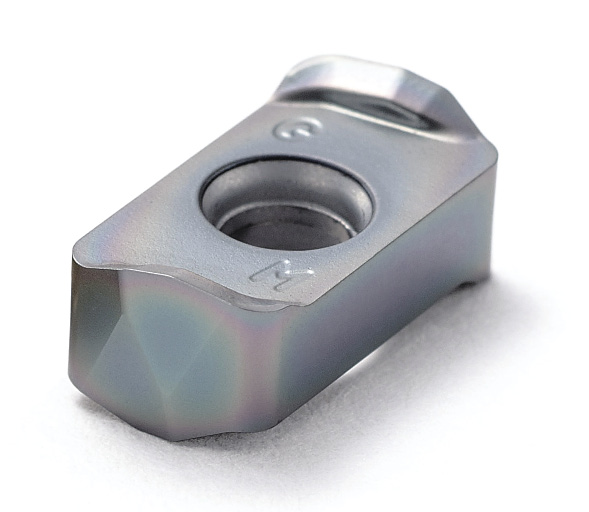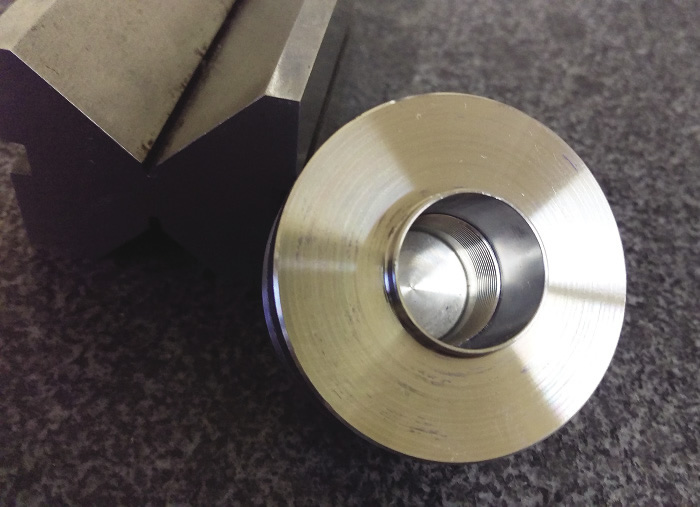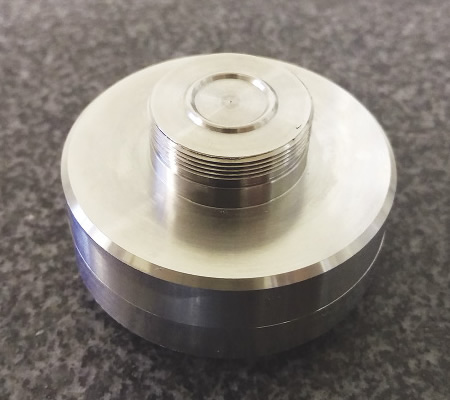
END USER: RJ Enterprises, (310) 327-8127, www.rjenterprise.net
SOLUTION PROVIDER: Kyocera Precision Tools Inc., (800) 823-7284, www.kyoceraprecisiontools.com
CHALLENGE: Reduce cycle time when roughing a fuel sensor made of 304 stainless.
SOLUTION: Switching from a ½"-dia., 4-flute solid-carbide endmill to a 5⁄8"-dia., indexable-insert endmill.

Steady production of parts for a long-term contract can motivate a job shop to push its cutting tools hard to meet customer delivery requirements. RJ Enterprises found itself in that situation when roughing a 304 stainless steel fuel sensor and was willing to sacrifice tool life to achieve productivity needs.
Owner Vartan Akrabian explained that the Gardena, Calif., shop was applying a ½"-dia. (12.7mm), 4-flute solid-carbide endmill at a cutting speed of 350 sfm (106.7 m/min.), a feed of 15 ipm (381 mm/min.) and a DOC of 0.050" (1.27mm) but was achieving an unacceptable cycle time of about six parts per hour.
Tool life was six parts per endmill, he added, and the tools experienced chipping and premature failure.
The yearly quantity for the fuel sensor project is about 2,400 parts, and the job is scheduled to run for 5 years, Akrabian said.
RJ Enterprises requested assistance from Hendersonville, N.C.-headquartered Kyocera Precision Tools Inc. The toolmaker recommended its 5⁄8"-dia. (15.875mm), 3-flute MFH-Mini Raptor endmill tooled with its PR1535 inserts. The PVD-coated, double-sided inserts have four cutting edges.
“If it worked out, we would buy it, and, if not, we would return it without paying for it,” Akrabian said.
Kyocera Precision Tools reportedly provides a guaranteed test-tool program to all of its customers.


Kyocera’s Raptor-Mini endmill accepts the toolmaker’s PR1535 double-sided inserts (below), which have four cutting edges. Images courtesy Kyocera Precision Tools.


Scott Pettay, field sales engineer for Kyocera, noted RJ Enterprises was able to switch to a larger endmill because the tool is for machining the part OD. He added that Akrabian initially thought he would have to apply an endmill smaller than ½" in diameter to reduce tool pressure.
With the indexable-insert endmill, RJ Enterprises now roughs at a cutting speed of 250 sfm (76.2 m/min.), a feed rate of 90 ipm (2,286 mm/min.) and a DOC of 0.020" (0.508mm). Although the indexable tool runs at a slower speed and takes a smaller DOC than the solid-carbide tool it replaced, Akrabian emphasized the productivity gains made possible by the six-fold increase in the feed rate: “We gave up the depth of cut, but we went from 15 ipm to 90 ipm. It’s smoking! I was hoping to cut the cycle time in half, but it went from an hour to 22 minutes for six parts.”
In addition, one cutting edge lasts for 12 parts, and a box of 10 inserts, which provides 40 cutting edges, costs about $80 compared to the approximate $50 price tag for the carbide endmill, Akrabian said. “It was a cost savings, overall.”
The company still finishes the part using a solid-carbide endmill, removing 0.010" to 0.015" (0.254mm to 0.381mm) of material, he added.
Pettay pointed out that the PR1535 insert offers versatility because it is suitable for milling stainless steel, titanium and Inconel. In addition to 304 stainless, Akrabian said RJ Enterprises uses it for cutting 420 stainless.
“In the future,” Akrabian said, “we will try different grades [to see] if they’ll improve cycle time or even the life of the tool.”


The 304 stainless fuel sensor before (above) and after (below) the roughing operation. Images courtesy RJ Enterprises.


Contact Details
Related Glossary Terms
- cutting speed
cutting speed
Tangential velocity on the surface of the tool or workpiece at the cutting interface. The formula for cutting speed (sfm) is tool diameter 5 0.26 5 spindle speed (rpm). The formula for feed per tooth (fpt) is table feed (ipm)/number of flutes/spindle speed (rpm). The formula for spindle speed (rpm) is cutting speed (sfm) 5 3.82/tool diameter. The formula for table feed (ipm) is feed per tooth (ftp) 5 number of tool flutes 5 spindle speed (rpm).
- depth of cut
depth of cut
Distance between the bottom of the cut and the uncut surface of the workpiece, measured in a direction at right angles to the machined surface of the workpiece.
- endmill
endmill
Milling cutter held by its shank that cuts on its periphery and, if so configured, on its free end. Takes a variety of shapes (single- and double-end, roughing, ballnose and cup-end) and sizes (stub, medium, long and extra-long). Also comes with differing numbers of flutes.
- feed
feed
Rate of change of position of the tool as a whole, relative to the workpiece while cutting.
- gang cutting ( milling)
gang cutting ( milling)
Machining with several cutters mounted on a single arbor, generally for simultaneous cutting.
- inches per minute ( ipm)
inches per minute ( ipm)
Value that refers to how far the workpiece or cutter advances linearly in 1 minute, defined as: ipm = ipt 5 number of effective teeth 5 rpm. Also known as the table feed or machine feed.
- milling
milling
Machining operation in which metal or other material is removed by applying power to a rotating cutter. In vertical milling, the cutting tool is mounted vertically on the spindle. In horizontal milling, the cutting tool is mounted horizontally, either directly on the spindle or on an arbor. Horizontal milling is further broken down into conventional milling, where the cutter rotates opposite the direction of feed, or “up” into the workpiece; and climb milling, where the cutter rotates in the direction of feed, or “down” into the workpiece. Milling operations include plane or surface milling, endmilling, facemilling, angle milling, form milling and profiling.
- outer diameter ( OD)
outer diameter ( OD)
Dimension that defines the exterior diameter of a cylindrical or round part. See ID, inner diameter.
